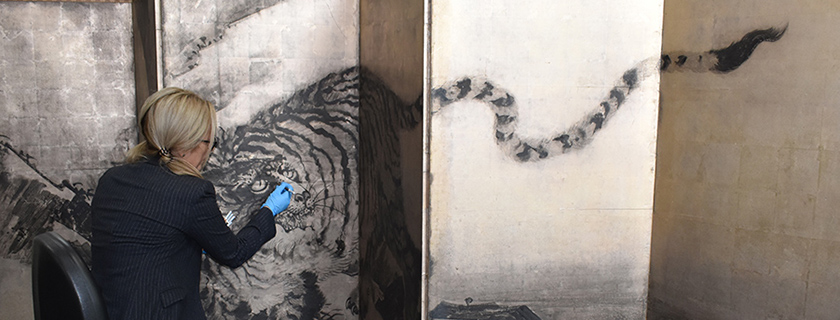 Conservation treatment, Dragon and Tiger, 1850, Japan. Pair of six-panel screens, colour, ink, silver alloy on paper, 175.0x 420.0 cm (each); Gift of Andrew and Hiroko Gwinnett through the Art Gallery of South Australia Foundation 2005, 20053A10
Conservation treatment, Dragon and Tiger, 1850, Japan. Pair of six-panel screens, colour, ink, silver alloy on paper, 175.0x 420.0 cm (each); Gift of Andrew and Hiroko Gwinnett through the Art Gallery of South Australia Foundation 2005, 20053A10
We care for significant works on paper for the state’s collections and consult with private clients, assessing and suggesting treatment options for artworks on paper requiring care and attention.
To begin conservation of a work art on paper, Artlab conservators carefully identify its medium and materials to determine the best practice for conservation.
The artwork could be made by drawing with pen, graphite, pencil, pastel or charcoal or painted with watercolour or gouache. More mechanical means of mark making with printmaking may also be identified and may include relief printing, lithography, etching, engraving, mezzotint and sometimes industrial printmaking including, but not limited to, half tone or chromolithography.
Paper may be handmade or industrially produced and be composed of different fibres and fillers.
Works of art on paper are usually brought to our paper conservators due to an aesthetic flaw which can be due to physical damage such as punctures, tears and creases to the paper or losses to the medium.
Light can also adversely alter the colour of the artwork and its paper support, which can create staining and coupled with high humidity, accelerates the risk of mould. Temperature and humidity influence the way paper naturally moves causing extreme undulation or stress, especially if the work is adhered to a secondary support.
Our conservators determine the suitability of the artwork’s current housing. A common treatment is to remove acidic backboards and stained top window mounts.
Conservation treatment including surface cleaning, washing, stain reduction and flattening may be undertaken to reduce acids and physically stabilise the paper. Tears and losses can be repaired and infills and retouching benefit the appearance.
Housing the artwork in suitable materials is imperative for preventative display, handling and storage strategy. It is remarkable the visual difference a simple new acid-free mount can make to an artwork!


